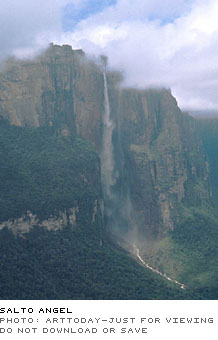|
At the farthermost point in southeast Venezuela, near its borders with Guyana and Brazil, in the Guyana Shield region, is the Canaima National Park. This area is the oldest rock formation in the world’s chronology, belonging to the Pre-Cambrian period, some 900 to 3500 million years ago. Its antiquity makes it important to geologists, but other things make the Canaima National Park attractive to scholars, ecologists, and the general public.
An infinite variety of natural resources, its exceptional size, landscapes of indescribable beauty, life, movement and color: all these make the park a natural wonder that continues to thrive. Canaima was made into a national park on June 12, 1962, with a surface of a million hectares. This area was increased to 3 million in 1975, and it was then that it became one of the largest national parks in the world. Majestic rivers are found in this ecological area, perhaps the most important being the Caroni River. This river flows across thick rain forests and crosses open savannahs, throwing itself down the numerous waterfalls that embellish the region and among which stand out Angel Waterfall, or Parecupa-meru, and Kukenan-meru: the first and fourth tallest waterfalls in the world.
A unique characteristic of the park is the “tepuyes”, or plateaus with a flat top that reach heights of over 9000 feet above sea level. They have vertically inclined walls that give the scenery a special look. Their height and isolation make each of the more than 100 “tepuyes” something like an ecological island with unique characteristics in flora and fauna. There are a great variety of faunas in the region, especially of the amphibian and reptile species. With regards to mammals, one can find the anteater, the tapir, the jaguar, the giant otter, the fox, and the araguato monkeys, some of which are endangered species. Among the birds, of which there are many, stand out the harpy eagle, the pigeon-eating falcon, the dwarf macaw, and the hummingbird. The park’s flora is heterogeneous. Various families of orchids and bromelias adorn the woodlands and rain forests. Species that can be found in no other part of the world grow at the top of the “tepuyes”: meat-eating plants that trap insects to supply the necessary nutrients that ensure their growth and development.
Life in Canaima is intense. Humans are also present in the region, represented by the Pemon ethnic group; these are indigenous inhabitants divided into three families: Arekunas, Taurepanes, and Kamaracotos. They are well integrated into nature and, like all traditionalist ethnic groups, respect and protect the environment on which they subsist. Rainforests, woodlands, rivers, and tepuyes; waterfalls, flora, and fauna; torrential rain, blue, open skies; a refuge to the greatest biodiversity and natural resources in the planet: Canaima, a majestic natural scenery, the pride of Venezuela,… of Latin people,… of the world…. Canaima National Park, an example of the best of the latin spirit. |
|
|
 Can
the oldest region in the planet be saturated with natural life
Can
the oldest region in the planet be saturated with natural life